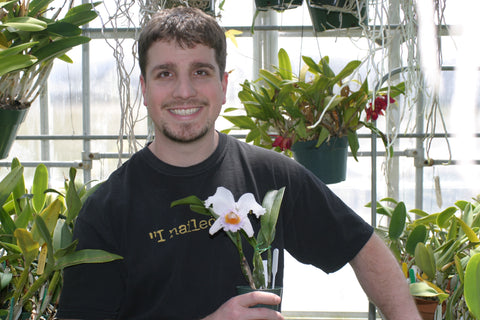Temperature and Humidity
Posted by Dave Off OrchidNerd.Com on

Temperature and Humidity
Normal home temperatures are fine for growing most orchids. Temperatures of 70-80 degrees in the daytime and 60-70 degrees at night are ideal. Always keep plants away from hot or cold drafts.
Many orchids, like phalaenopsis, need a drop in temperature for several weeks during the fall to set their flower spikes. This is accomplished by moving them outdoors or opening the window in which they are growing when the outside night temperature is in the mid to upper 50’s. Cymbidiums like to grow outside during the summer with plenty of light and fertilizer. They require a 20-30 degree drop in temperature in the late fall to set their flower spikes. So leave them outside until danger of frost.
If you have trouble growing cool or intermediate orchids, consider growing them in your basement under lights. Beware of cooling your orchids using an air conditioner as they remove humidity from the air and may cause the flowers to wilt. A good level of humidity in winter can be attained by running a humidifier or by putting humidity trays under your plants. Feel free to spray your orchids with a mister on any sunny day to increase the humidity level.
American Orchid Society says Virtually all orchids do best when humidity ranges from 40% to 70%. Even those that are adapted to growing under rather desert like conditions such as Zelenkoa (Oncidium) onusta are exposed to periods when the humidity is in this range. In this particular example, the species flourishes in coastal deserts where breezes from the pacific bring nightly dues and resultant relatively high humidity even though it may not rain for long periods.
Investing in an inexpensive humidity gauge is a necessity for all but the smallest collection if you want to grow orchids well. In virtually all parts of the United States outside of Hawaii and Puerto Rica, at some part of the year, it will be necessary to add supplemental humidity to the growing area. In some parts of the country such as the South and Southeast, humidity during the summer months will be adequate to even excessive while winter humidity levels may be too low, especially following strong cold fronts. In the Pacific Northwest, the situation may well be reversed with humid, cool winters and relatively low humidity during the warmer summer months. If you grow your plants in areas where supplemental heating is a requirement such heat sources dry out the air making humidity measurements critical. Having a simple humidity gauge takes the guesswork out of the growing area. Also keep in mind that humidity is usually highest at night and lowest during the afternoon peak of sunlight and warmth.


David Off ( Orchidnerd.com ) is a 3rd generation grower of Waldor Orchids. ( www.waldor.com )
David co-founder of www.waldor.com & Orchidnerd.com
Send your question to Email Orchid Nerd
| Join Our Mailing List |
Share this post
0 comment


